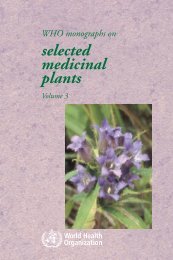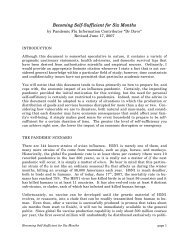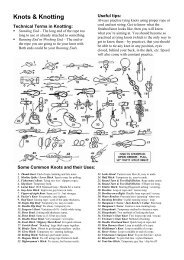Create successful ePaper yourself
Turn your PDF publications into a flip-book with our unique Google optimized e-Paper software.
WHITE SPORE PRINT<br />
wide have been found several times by the author and doubtless<br />
by many others. In dense forests of mixed hardwoods we have<br />
come upon large fairy rings made up of perfect specimens approaching<br />
this size, and with their brightly colored caps they<br />
made an impressive sight.<br />
The average cap is from 6 to 8 inches wide, and the color varies<br />
from straw-yellow to reddish orange, the reddish shades being<br />
more typical. The surface is spotted with large white or pale yellow<br />
warts that are likely to be distributed in circles, but these<br />
warts may be shed from old specimens. The gills are white or<br />
very pale yellow and scarcely touch the stem. The flesh is white,<br />
spongy, and brittle. The stem is from 1/4 to 1/2 inch wide at the<br />
top, gradually increasing in diameter toward the bulbous base.<br />
The soft, white ring is at first very conspicuous but soon dries and<br />
disappears. The volva typically shows up only as a series of partial<br />
ridges on the bulbous base of the stem; that is, there is no true<br />
volva but only a hint or suggestion of one. This species has more<br />
than once been mistaken for Amanita caesaria, one of the few<br />
edible species of Amanita, which is fortunately more common in<br />
Southern Europe than here.<br />
Poisonous: AMANITA RUSSULOIDES<br />
Though not so common as the two preceding species, this one<br />
is found in large numbers during the late spring and summer of<br />
certain years. It is supposedly, but not certainly, poisonous and<br />
should by all means be avoided. We have found it in scattered<br />
colonies in deciduous forests, but it is not likely to appear in the<br />
same place every year.<br />
The plants are sturdy and attractive, as the illustrations indicate<br />
(see Figure u and Plate 36), with caps from about 4 to 6 inches<br />
wide, straw-yellow or nearly white, very sticky when fresh and<br />
moist, and bearing thick, soft, white warts that look almost artificial.<br />
As the plants age, the caps become quite flat, the specimen<br />
pictured being still in the prime of life. The edge of the cap is<br />
marked with prominent radial ridges. In large specimens the stem<br />
33
















